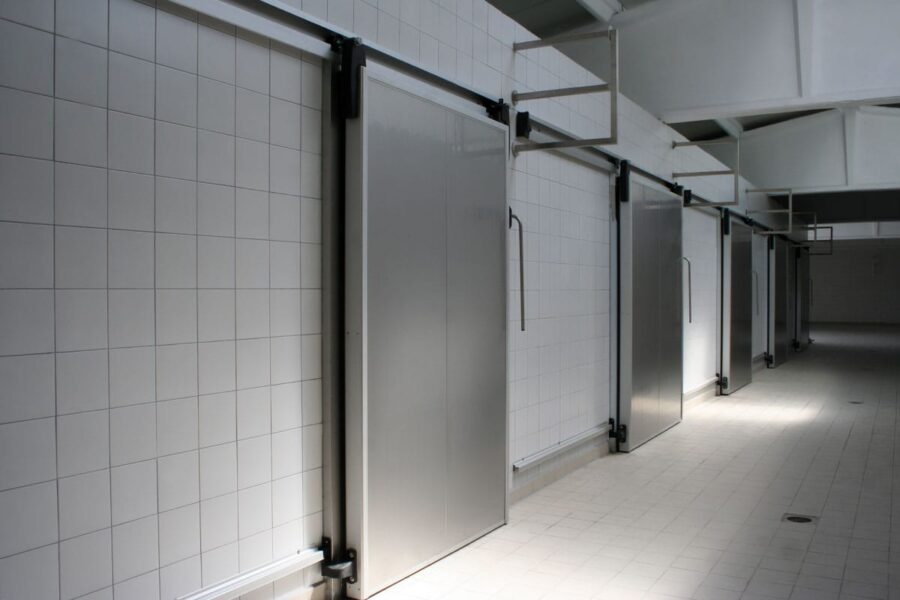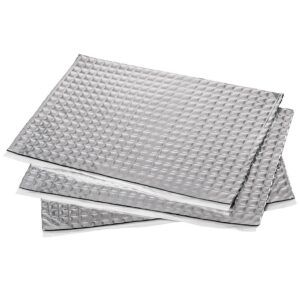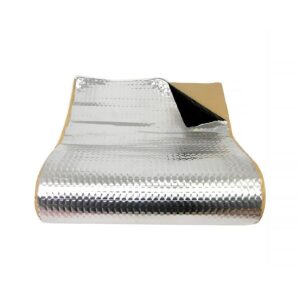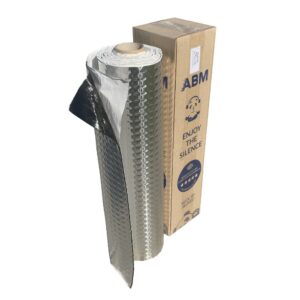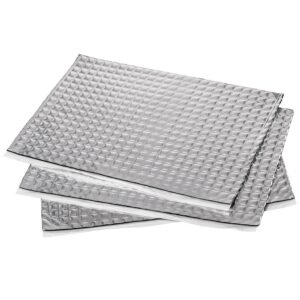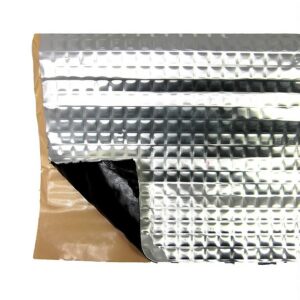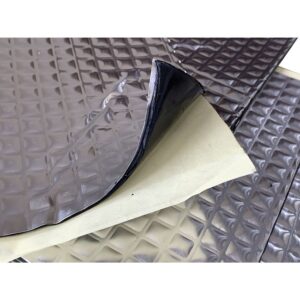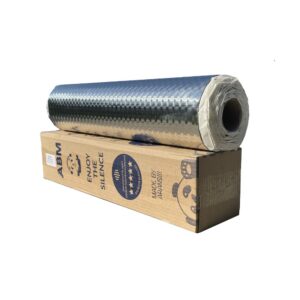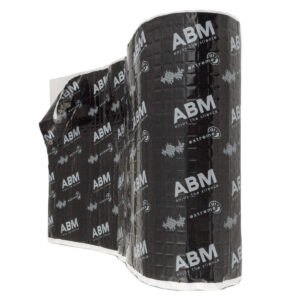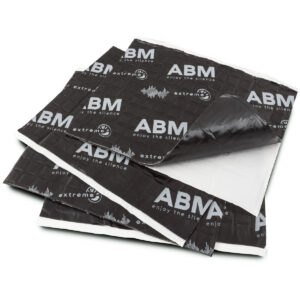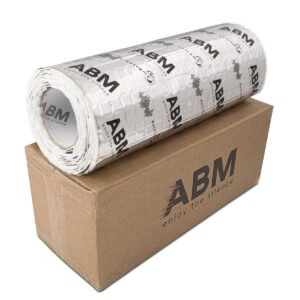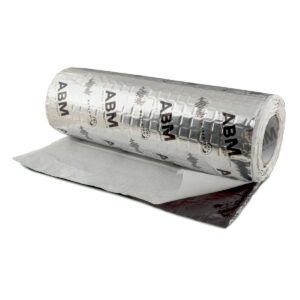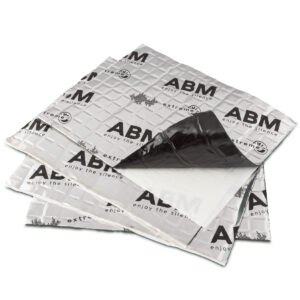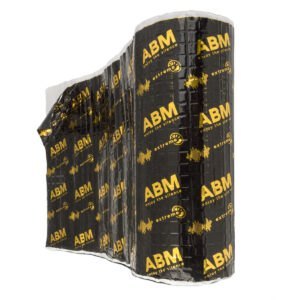Industrial refrigerators and cold rooms generate a significant level of noise during daily operation. Compressors, compressors, and refrigeration units produce unpleasant sounds that reduce comfort in storage rooms. Vibrations are transmitted through metal housings and pipelines. Employees exposed to constant noise experience fatigue and discomfort.
Soundproofing materials, especially butyl mats, provide an effective solution to the problem of excessive noise. The special construction of butyl enables the absorption of vibrational energy and reduction of mechanical sounds. The elastomer layer combined with aluminum foil creates an acoustic barrier. ABM Insulation offers professional products tailored to industrial conditions.
The use of butyl mats in refrigeration equipment brings measurable benefits. Noise levels drop by several decibels. Staff work comfort significantly improves. Proper insulation also protects against heat energy loss.
Vibration damping properties of butyl mats used in refrigeration equipment
Butyl mats exhibit exceptional vibration damping capabilities generated by refrigeration devices. The dense material structure absorbs mechanical energy before it transforms into noise. The high elasticity of butyl allows effective performance under harsh conditions. The material adapts to various surfaces without losing insulating properties.
Butyl is characterized by a mechanical energy loss factor surpassing most competing materials. This property directly translates into soundproofing efficiency. The molecular structure of butyl converts vibrational energy into a small amount of heat. This process occurs continuously during device operation.
The operating temperature range for butyl mats extends from minus 40 to 170 degrees Celsius. This parameter allows use in different zones of refrigeration equipment. The material retains flexibility even at low temperatures. Thermal stability ensures long-term performance without property degradation.
Mechanism of vibrational energy absorption from compressors and compressors
Compressors and compressors are the main sources of vibrations in refrigeration systems. Piston movement and rotating parts generate vibrations at various frequencies. Mechanical energy transfers through mounting points to the device housing. Metal surfaces act like speaker membranes, amplifying noise.
Butyl mats glued to the housing absorb vibrational energy before it spreads further. The elastomer structure works like a multilayer vibration damper. Each vibration wave loses part of its energy passing through the material. This process repeats multiple times, effectively silencing the device.
The thickness of the butyl layer directly affects damping effectiveness. Mats with thicknesses from 1.3 to 4 mm offer different levels of insulation. Thinner versions work well for moderate noise levels. Thicker layers eliminate strong vibrations from large industrial compressors.
Elastomeric structure ensuring high effectiveness across a wide frequency range
The elastomeric construction of butyl mats allows for sound attenuation from 50 to 5000 Hz. Low frequencies originate from the operation of compressors and electric motors. High tones are generated by bearings, fans, and flowing refrigerants. The versatility of the material eliminates the need for multiple different insulations.
Butyl demonstrates the highest effectiveness in the low-frequency range, which is most troublesome to the human ear. The droning sounds from refrigeration units effectively disappear after applying the mats. Mid-range frequencies are also significantly reduced. Comprehensive soundproofing improves acoustic conditions throughout the room.
Properties of damping materials:
- Butyl absorbs mechanical vibrations over a wide frequency spectrum
- The flexible structure adapts to the dynamic operation of the device
- The material does not lose its properties under repeated load cycles
- Dimensional stability prevents deformation during use
- High adhesion maintains bonding with surfaces for years of operation
Aluminum layer enhancing thermal and fire resistance of the material
A 0.1 mm thick aluminum foil is an integral part of ABM butyl mats. The metal layer performs several key functions in refrigeration equipment contexts. Aluminum reflects thermal radiation, minimizing energy losses. This property supports the energy efficiency of the cooling system.
Fire resistance gains importance in industrial spaces. Aluminum does not burn and limits fire spread. The metal layer also protects butyl from mechanical damage. Tear resistance increases tenfold compared to butyl alone.
The aluminum surface facilitates installation and quality control of application. The shiny layer allows checking for uniform adhesion. The material reflects light, easing work in poorly lit areas. An aesthetic appearance matters in visible installation locations.
Butyl density as a key parameter in reducing mechanical noise
The density of ABM butyl mats is approximately 1.6 grams per cubic centimeter. This parameter significantly exceeds that of lighter foam materials. High specific mass directly translates into vibration damping capability. Heavier material more effectively absorbs mechanical energy.
Increased density provides a better barrier against sound waves. Sound has difficulty penetrating dense media. This effect is especially noticeable at low frequencies. Industrial refrigerators mainly generate noise in the range from 50 to 200 Hz.
The balance between mass and efficiency requires a thoughtful approach. Butyl mats provide high effectiveness at moderate weight. One square meter weighs from 0.5 to 1.5 kilograms depending on thickness. The added mass does not overly burden refrigeration equipment structures.
Before purchasing butyl mats, it is advisable to measure surfaces requiring insulation. Accurate measurements allow ordering the appropriate amount of material without excess. ABM Professional mats are available in sheets and rolls of various dimensions.
Sources of Noise in Professional Refrigeration Systems Requiring Insulation
Refrigeration systems consist of many components that generate noise. Each element requires an individual approach to acoustic insulation. Identifying the sources of sound is the first step to effective noise reduction. Professional decibel level measurements indicate the most problematic areas.
Piston compressors produce vibrations with high amplitude. The reciprocating motion of the pistons results in pulsating noise. Screw compressors operate more quietly but also require insulation. Rotating elements generate high-frequency vibrations. Each type of device needs a tailored acoustic solution.
Refrigeration units combine several noise sources within one enclosure. The electric motor, compressor, and fans operate simultaneously. This creates a complex acoustic profile requiring comprehensive soundproofing. Butyl mats reduce all noise components evenly.
Vibrations Transmitted Through Copper Pipelines and Cooling Lines
Copper pipelines transmit vibrations from the compressor throughout the system. The pulsating flow of refrigerant generates additional noise. Pipes act as resonators, amplifying certain frequencies. Long sections of piping spread sound throughout the entire room.
Pipeline mounting points act as acoustic bridges. Vibrations pass through metal brackets directly to the building walls. The building structure transmits noise over considerable distances. This effect intensifies especially in empty warehouse spaces.
Insulating pipelines requires using butyl mats in strategic locations. Wrapping pipes near the compressor reduces vibration transmission. Lining mounting points interrupts sound propagation paths. A comprehensive approach eliminates most noise related to the installation.
Rattling of Metal Enclosures During Unit Operation
Metal enclosures of refrigeration units tend to resonate. Thin steel or aluminum sheets vibrate due to internal vibrations. Large surface areas become secondary sources of noise. This effect significantly increases the overall sound level in the room.
The resonance frequency of the sheet depends on its dimensions and thickness. Most enclosures resonate in the range from 80 to 300 Hz. This range overlaps with dominant compressor operating frequencies. The overlap leads to unpleasant rattling.
Applying butyl mats on the interior surfaces of the enclosure eliminates resonance. Added mass and damping change the vibration characteristics of panels. The sheet stops acting like a speaker diaphragm. Noise reduction ranges from 10 to 20 decibels depending on construction.
Resonance of Side Panels and Covers in Large-Scale Equipment
Industrial coolers have large side panels with an area of several square meters. Extensive surfaces are particularly prone to vibrations and resonance. Even weak excitation causes visible surface vibrations. Noise spreads throughout the entire production hall or warehouse.
Access covers and service doors are additional sources of noise. Installation clearances allow relative vibrations of components. Cracks and knocks occur during device operation. Weak mechanical connections transmit vibrations between components.
Areas requiring special attention:
- Large side panels of the enclosure should be completely covered with butyl mats
- Service covers require insulation along the edges and in the center
- Access doors benefit from an additional soundproofing layer
- Internal partitions, often overlooked during installation, deserve insulation
- Ceiling panels in refrigeration chambers also transmit vibrations
The largest side panels should be covered with butyl mats first. Reducing the resonance of large surfaces provides the most noticeable acoustic effect. Subsequent layers are applied to smaller structural elements.
Techniques for applying soundproofing materials on industrial refrigeration surfaces
The effectiveness of butyl mats largely depends on installation quality. Proper surface preparation is the foundation of a durable installation. Even the best material will not perform its function if applied incorrectly. The process requires precision but not specialized skills.
The ambient temperature during installation should be between 15 and 25 degrees Celsius. These conditions ensure optimal adhesive layer properties. Lower temperatures hinder adhesion and require heating the material. Higher temperatures may cause deformation during application.
ABM Professional Butyl Mats and ABM Xtreme have a self-adhesive layer. This solution eliminates the need for additional adhesives. Simply peel off the protective film and press the material onto the surface. Strong adhesion develops within the first 24 hours.
Surface preparation and cleaning of oil residues and dust
Metal surfaces of refrigeration devices are often covered with a layer of maintenance oil. Industrial grease protects against corrosion but prevents effective mat adhesion. Thorough degreasing is a key preparation step. Neglecting this step leads to insulation detachment.
Isopropyl alcohol-based products effectively remove grease and oil. The agent should be applied generously, and the surface must be wiped dry. Cleanliness is checked by attempting to stick a piece of tape. If the tape holds firmly, the surface is ready for insulation.
Dust and mechanical dirt also need to be removed. Dust particles create a barrier between the adhesive and metal. The cleaned surface must be completely dry. Moisture prevents proper adhesion and can lead to corrosion under insulation.
Corroded areas require mechanical cleaning. Rust is a weak substrate for the adhesive layer. A wire brush or sandpaper removes loose buildup. After cleaning, the area should be degreased and protected with anti-corrosion paint.
Placement of the Self-Adhesive Layer on Internal and External Walls
Internal insulation provides direct damping of vibration sources. Mats glued inside the enclosure absorb noise before it spreads further. Access to the interior requires partial disassembly of the device. The work should be carried out by a qualified technician familiar with the unit’s construction.
The application starts with the largest flat surfaces. The material is pressed from the center toward the edges, pushing out air bubbles. A rubber roller or smooth roller helps evenly distribute pressure. Firm pressing ensures full adhesive contact with the substrate.
External insulation complements soundproofing and does not require structural modifications. Mats applied to external panels dampen enclosure resonance. This method is simpler and faster than internal insulation. Effectiveness reaches 70 percent of the results obtained with full insulation.
| Parameter | Internal Insulation | External Insulation |
|---|---|---|
| Noise Reduction | 15-20 dB | 10-15 dB |
| Installation Difficulty | High | Low |
| Access to Device | Requires disassembly | No intervention needed |
| Solution Durability | Very high | High |
| Implementation Cost | Higher | Lower |
Protection of Compressor Mounting Points and Vibrating Components
Compressor mounting points are the main pathways for vibration transmission. Bolts and brackets transfer vibrations directly to the device frame. Insulating these areas yields disproportionately large acoustic effects. Even a small surface of butyl mats significantly reduces noise.
Butyl pads placed between the compressor and the frame interrupt the vibration path. A material thickness of 3-4 mm provides effective insulation. The flexible structure absorbs vibrations before they transfer to the construction. This solution works in conjunction with factory rubber shock absorbers.
Brackets and mounts also require insulation. Wrapping metal components with a layer of butyl reduces sound transmission. Special attention is given to contact points with the casing. Every contact point is a potential acoustic bridge that needs to be interrupted.
Sealing Gaps and Structural Joints Prone to Sound Propagation
Gaps in refrigeration equipment enclosures allow noise to escape outside. Small technical holes act like resonance holes in musical instruments. The sound amplifies and escapes with greater intensity. Sealing these areas is an important element of insulation.
ABM butyl mats exhibit excellent sealing properties. The flexible material fills irregularities and gaps. Once adhered, it creates a tight barrier against sound waves. This solution also eliminates airflow carrying noise.
Panel joints and cover edges require special attention. These areas often represent the weakest link in acoustic insulation. Narrow strips of butyl mats applied along gaps eliminate sound leaks. Additional mass also dampens vibrations at panel edges.
Tip: Using an inspection lamp inside the enclosure helps identify all gaps. Light shining through indicates areas requiring sealing. This method is simple and reliable during preparation for insulation.
Comparison of Effectiveness of Different Methods for Silencing Food Storage Equipment
The market offers several types of insulating materials for refrigeration equipment. Each solution has different properties and applications. Choosing the right material depends on installation specifics and user requirements. Comparing effectiveness helps make an informed purchasing decision.
Acoustic foams are a popular alternative to butyl mats. Lightweight and easy-to-apply materials have wide usage. However, their damping effectiveness differs significantly from butyl solutions. Each material type performs best under different operating conditions.
The cost of insulation should not be the only selection criterion. Durability and long-term effectiveness have key economic importance. A cheaper solution requiring frequent replacement ultimately generates higher costs. Analyzing total cost of ownership leads to rational investment choices.
Butyl Mats Compared to Open-Cell Acoustic Foams
Open-cell acoustic foams absorb sound waves. Their mechanism of action fundamentally differs from vibration damping by butyl. Foam primarily reduces reflected sounds and reverberation within a room. Butyl eliminates vibrations at the source before they turn into noise.
The density of butyl mats exceeds that of acoustic foams by ten times. This difference directly translates into effectiveness in damping low frequencies. Foams perform well with high tones from 1000 Hz upwards. Industrial refrigerators mainly generate noise below 500 Hz.
The combination of both materials provides the best acoustic results. Butyl mats on the casing damp mechanical vibrations. Acoustic foam on the room walls absorbs the spreading sound. This comprehensive solution reduces noise by 25-30 decibels.
Comparison of insulation material properties:
- Butyl effectively dampens low frequencies from compressor operation
- Foam absorbs high tones and reduces acoustic reverberation
- The specific mass of butyl provides a better barrier to sound waves
- Foam weighs less but requires a thicker layer
- The combination of both materials produces a synergistic soundproofing effect
Durability of Solutions under Long-Term Exposure to Low Temperatures
Low temperatures pose a challenge for many insulation materials. Industrial refrigeration chambers operate in the range from minus 25 to plus 5 degrees Celsius. Materials must maintain flexibility and adhesive properties under these conditions. Butyl demonstrates excellent stability throughout the entire operating temperature range.
Polyethylene foams may harden at low temperatures. Loss of elasticity leads to cracks and detachment from the substrate. These materials perform better at temperatures above freezing. ABM butyl mats retain their properties down to minus 40 degrees.
Freezing and thawing cycles test insulation durability. Thermal contraction and expansion cause mechanical stresses in materials. Butyl remains flexible and absorbs these deformations without damage. Foam may degrade after many temperature cycles.
Retention of Adhesive Properties in Humid and Freezing Conditions
Moisture is a constant element in refrigeration device environments. Condensation of water vapor on cold surfaces is inevitable. The adhesive layer must maintain adhesion despite the presence of water. ABM Professional butyl mats exhibit excellent moisture resistance.
Butyl adhesive does not react with water and does not undergo hydrolysis. This property ensures a durable bond even in an environment with 100% humidity. Water does not penetrate through the butyl layer to the metal substrate. This solution additionally protects against corrosion.
Acoustic foams absorb moisture, leading to increased weight and loss of properties. Wet material loses its ability to absorb sound. Frozen water within foam structure can cause cracks. Butyl mats do not exhibit these problems during use.
Tip: Installation of butyl mats in refrigeration chambers should be carried out before system startup. Installation at room temperature ensures optimal adhesion conditions. After cooling is started, the material retains all its properties.
Butyl Mats in the ABM Insulation Store
ABM Insulation Store is a reliable source of high-quality insulation materials for professionals and individual customers. It offers comprehensive solutions for soundproofing refrigeration equipment, industrial machinery, and office spaces. The versatile assortment allows finding the right product for every application and budget.
ABM Insulation has specialized in supplying insulation materials since 2010. Fast delivery within Poland and European Union countries is a key advantage. Guaranteed highest quality materials and professional advice support customers in choosing optimal insulation solutions tailored to specific needs.
Professional Butyl Mats for Demanding Tasks
The ABM Professional Butyl Mat Line includes materials in sheets and rolls of various thicknesses. The products feature a strong adhesive layer allowing installation without heating. The flexible butyl structure adapts to multiple installation tasks without losing properties. Effective vibration damping from compressors and pumps reduces noise by 10 to 15 decibels.
Key features of the professional line:
- Thickness from 1.3 to 4 millimeters adapted to different work intensities
- Self-adhesive layer ensuring durable bonding with metal
- Temperature resistance from minus 40 to plus 170 degrees Celsius
- No asphalt in composition eliminating risk of cracks and deformations
- Use in industrial refrigerators, cold rooms, and freezing chambers
Butyl Soundproofing Mats ABM Professional in the ABM Insulation store
Extreme Soundproofing for Demanding Conditions
The Extreme Line of ABM Xtreme Butyl Mats offers a premium option for the toughest working conditions. The material demonstrates exceptional flexibility and mechanical durability. A 0.1-millimeter aluminum foil enhances thermal and fire resistance. Effectiveness in damping low frequencies up to 100 hertz reaches levels of 18 to 20 decibels.
Specialized properties of the extreme line:
- Exceptional flexibility allowing installation in uneven places
- Efficient adhesive layer maintaining adhesion in extreme conditions
- Use in large cold storage areas with complex geometries
- Resistance to freezing and thawing cycles without loss of properties
- Certificates confirming safety in contact with food and refrigerants
Butyl Soundproofing Mats ABM Xtreme in the ABM Insulation store
ABM Xtreme Premium Self-adhesive Butyl Soundproofing Mat in rolls, 2.5mm, 2m2
Acoustic Butyl Mat Self-adhesive ABM Xtreme Premium in rolls, 2.0mm, 2m2
ABM Insulation Shop ensures purchase security through quality certificates and product warranties. Fast order processing within 24 hours of purchase confirmation makes shopping a convenient process. Professional customer service assists in selecting the right material based on specific requirements. Trust proven insulation solutions and enjoy silence and comfort in any space.
Contact us for an individual consultation regarding the selection of the best insulation materials for specific applications. Our team of specialists will provide expert advice and guidelines on proper installation. Discover the ABM Insulation Shop offer and find the perfect solution to soundproof your refrigeration installations or industrial machinery.
Results of Decibel Level Reduction in Real Warehouse Applications
Theoretical properties of insulation materials require practical confirmation. Acoustic measurements under real conditions provide reliable data. Case studies from various industries demonstrate the effectiveness of butyl solutions. Photographic and sound level meter documentation complements the analysis of results.
Food processing plants using acoustic insulation report significant improvement in working conditions. Staff operating cold storage rooms experience less fatigue after their shifts. Communication among employees becomes easier with lower noise levels. Benefits go beyond mere acoustic comfort.
Measurements before and after applying butyl mats provide objective data. Professional sound level meters record sound pressure levels at various points. Spectral analysis shows reduction across specific frequency bands. Results clearly confirm the effectiveness of butyl insulation.
Case Study: Soundproofing a Hall with Cold Storage Chambers in a Food Processing Plant
A meat processing plant in central Poland struggled with excessive noise. Five cold storage chambers operated simultaneously in the main production hall. Noise levels exceeded 85 decibels at a distance of three meters. Employees complained about difficulty concentrating and headaches.
The refrigeration units for each chamber had 2 mm thick steel sheet enclosures. Large panel surfaces resonated during compressor operation. Refrigerant pipelines ran along the hall ceiling without insulation. The entire system created mutually reinforcing noise sources.
The insulation project involved the application of ABM Professional butyl mats to all chambers. The internal side panels were covered with 2 mm thick mats. The unit covers received a double layer of insulation with a thickness of 4 mm. The pipelines were wrapped with strips of mats for a length of 2 meters from the compressors.
The project was completed in three working days by a two-person team. Each chamber required about 15 square meters of material. The total cost of the butyl mats was approximately 1125 EUR. The simple installation did not require shutting down the refrigeration equipment.
Noise level measurements before and after applying butyl insulation
Preliminary measurements were conducted at all five operating chambers. The sound level meter was placed at five measurement points inside the hall. Distances from the equipment were 1, 3, 5, 10, and 15 meters. Measurement time at each point lasted 5 minutes to obtain an averaged value.
The noise level near the chambers reached 88 decibels at a distance of one meter. At three meters, the value dropped to 82 decibels. The center of the hall was characterized by a level of 75 decibels. Even at the farthest point, noise exceeded 68 decibels. These values significantly exceeded acoustic comfort standards.
Control measurements were performed one week after completing the insulation of all chambers. Identical measurement points and operating conditions ensured comparability of results. The same sound level meter as during preliminary measurements excluded systematic errors. Measurements were repeated twice to confirm result stability.
| Distance from cells | Before insulation | After insulation | Noise reduction |
|---|---|---|---|
| 1 meter | 88 dB | 73 dB | 15 dB |
| 3 meters | 82 dB | 68 dB | 14 dB |
| 5 meters | 78 dB | 65 dB | 13 dB |
| 10 meters | 72 dB | 61 dB | 11 dB |
| 15 meters | 68 dB | 59 dB | 9 dB |
The Impact of Soundproofing on the Work Comfort of Industrial Refrigerator Staff
A survey conducted among plant employees showed a significant improvement in perceptions. Ten people working in the hall answered questions before and after insulation. The subjective acoustic comfort scale increased by an average of 60 percent. Employees unanimously rated the change as very positive.
Verbal communication between workstations became possible without raising voices. Previously, it was necessary to use gestures or approach the interlocutor closely. Noise reduction enabled normal conversations at a distance of several meters. This improvement translates into safety and work efficiency.
Fatigue after an eight-hour shift decreased according to staff reports. Noise causes physiological stress even when the employee becomes accustomed to it. A quiet work environment allows the body to function without additional strain. The long-term health benefits are hard to overestimate.
Benefits reported by employees:
- Reduced feeling of fatigue at the end of the work shift
- Improved concentration during precise tasks
- Easier communication without the need to raise voices
- Reduction of nervous tension related to constant noise
- Overall improvement in well-being while in the hall
Photographic documentation before starting insulation work facilitates planning and progress control. Photos of each chamber from different perspectives show areas requiring attention. This material also helps with potential future system expansions.
FAQ: Frequently Asked Questions
What is the minimum thickness of butyl mat necessary for effective noise reduction from industrial refrigerators?
The minimum thickness of the butyl mat is 1.3 millimeters. However, for professional refrigeration systems, thicknesses from 2 to 4 millimeters are recommended. Greater material thickness results in better damping, especially at low frequencies. Industrial refrigerators mainly generate noise below 500 hertz, where mats with a thickness of 4 millimeters show the best results. Experimentally, it has been shown that doubling the thickness reduces noise by about 6 decibels. The choice of thickness should depend on compressor workload intensity and available investment budget.
Butyl mats from ABM Insulation are available in five thickness variants. All have an aluminum layer 0.1 millimeters thick that enhances thermal resistance. The material density is approximately 1.6 grams per cubic centimeter for all sizes. Such standardization ensures reliable soundproofing results regardless of chosen thickness. Installing thicker variants requires applying greater force when pressing onto surfaces. Professionals often apply mats in two layers on critical points.
Can butyl mats peel off in cold storage rooms with continuous temperature and humidity changes?
The adhesive layer of ABM Professional butyl mats has been specially formulated to operate in extreme temperature conditions. The material maintains its tackiness at temperatures ranging from minus 40 to plus 170 degrees Celsius. Freeze-thaw cycles tested by the manufacturer indicate adhesion stability. Mats only peel off due to improper surface preparation. Oil, grease, or metal dirt prevent proper adhesion of the adhesive layer.
Butyl adhesive does not undergo hydrolysis in humid conditions. Water does not affect the adhesive properties and does not cause creep between the material and metal. Mold resistance is an additional advantage in refrigeration rooms where humidity reaches 100 percent. The material’s elongation is 300 percent, allowing it to adapt to thermal shrinkage without damage. The manufacturer guarantees adhesion durability for five years of use with proper installation. However, this requires careful substrate preparation and cleaning of oil residues and dust.
How many decibels does a butyl mat typically reduce in a professional cold storage facility with four chambers operating simultaneously?
Noise reduction depends on the size of the chambers and insulation density. For four chambers each with a volume of 20 cubic meters, the average reduction ranges from 10 to 15 decibels. Noise levels drop from about 85 decibels to 70 to 75 decibels at three meters from the units. This effect requires covering both internal and external surfaces of the enclosure. External insulation alone results in a smaller reduction of about 8 decibels.
The degree of effectiveness depends on several factors:
- The thickness of the applied insulation layer and number of layers
- The accuracy of covering the entire enclosure without leaving gaps
- Additional insulation of refrigeration pipelines and mounting points
- The technical condition of refrigeration units and bearing efficiency
- The presence of fans and their noise level during operation
In cold storage facilities with large side surfaces, the effect may be more noticeable. Metal panels are the strongest source of resonant noise. Covering side panels with butyl mats results in a reduction from 12 to 18 decibels. Uninsulated pipelines remain a potential noise source transmitting sound through the building. Comprehensive soundproofing of all components using ABM Insulation’s system achieves reductions up to 20 decibels.
Do butyl mats protect against heat loss in cold storage facilities and affect electricity costs?
In addition to vibration damping, butyl mats serve as thermal insulation. A butyl layer 2 millimeters thick reduces heat flow equivalently to a 5-millimeter mineral wool layer. Aluminum foil reflects thermal radiation toward the insulated interior. This effect reduces energy loss through the cold storage enclosure by 5 to 15 percent depending on size. In large cold storage facilities, energy savings can reach approximately €500 annually. Investment in butyl mats pays off within three to five years of operation.
Energy benefits of butyl mats:
- Reducing the number of compressor cycles thanks to better insulation
- Stabilizing the temperature inside the cold storage without sudden fluctuations
- Reducing electricity demand by 5 to 15 percent
- Protecting compressors from overheating during the summer season
- Extending the lifespan of refrigeration units due to lower load
- Reducing carbon dioxide emissions related to energy savings
The insulating effect materially impacts the long-term operational costs of the installation. Additionally, employees operating cold storage in moderate temperature conditions work more safely and efficiently. It is sufficient to apply mats with a thickness of 2 to 3 millimeters on all housing surfaces.
Can butyl mats be used in cold storage rooms without turning off the cooling system during installation?
Installing butyl mats is possible without shutting down the cooling system. However, special safety procedures must be followed. Workers should wear gloves and protective clothing due to the low temperatures inside the chamber. There is a risk of frostbite on the skin from direct contact with metal surfaces. Installation must be carried out quickly to minimize impact on the cooling system’s operation.
Mats should be cut into smaller pieces before bringing them into the cold storage chamber. Only inside the chamber should the protective film be peeled off and the material applied to surfaces. The temperature in the chamber usually ranges from minus 25 to minus 10 degrees Celsius. The adhesive layer of ABM Insulation mats retains its tackiness even under such conditions. However, it is recommended to limit working time to 30 minutes to ensure adequate worker insulation.
Safe installation procedures in operating cold storage chambers:
- Preparing the entire batch of mats for installation outside the chamber
- Cutting material into appropriately sized pieces
- Installation in two-person teams with worker rotations every 30 minutes
- Using dry work gloves insulating against cold
- Stopping work at signs of frostbite
- Checking accuracy of material adhesion immediately after installation
Alternatively, installation can be performed during regular maintenance breaks in the system. It is much safer to turn off cold storage for 4 to 8 hours and carry out installation at room temperature. Butyl mats then require 24 hours to achieve full adhesive strength. This procedure reduces injury risk for workers and guarantees better installation quality.
Summary
Butyl mats provide an effective solution for excessive noise issues in industrial refrigerators and cold storage rooms. The special elastomeric structure effectively dampens vibrations from compressors and refrigeration units. The aluminum layer enhances thermal and mechanical resistance of the material. Butyl density ensures high efficiency across a wide range of sound frequencies.
Proper application requires thorough surface preparation and cleaning. The self-adhesive layer facilitates installation without specialized tools. Insulating compressor mounting points and sealing structural gaps yield the greatest effects. A comprehensive approach to soundproofing ensures noise reduction from 10 to 20 decibels.
Documented cases of applications demonstrate measurable benefits of butyl insulation. Phonometer measurements confirm a significant reduction in noise levels. Employees operating refrigeration equipment experience improved comfort and reduced fatigue. The investment in soundproofing quickly pays off through better working conditions and increased staff efficiency.

